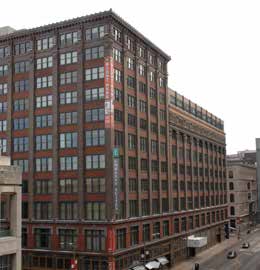

PROJECT DESCRIPTION
The Laurel project was the $175 million conversion of a historic building in downtown St. Louis into a new mixed-use facility that serves as a cornerstone for the city’s downtown redevelopment efforts. The project involved the substantial rehabilitation of the vacant Dillard’s department store located on Washington Avenue in the central business district. The HIT provided $45 million in financing for the project’s residential component, which features the conversion of 375,507 square feet, or 61% of the building, into 205 units of rental housing. The residential area includes almost 32,000 square feet of ground floor retail space, 350 interior parking spaces, and a 10,000 square-foot interior atrium.
HIT ROLE
The HIT provided financing for The Laurel through a $45 million FHAinsured construction and permanent mortgage loan securitized with a Ginnie Mae mortgage-backed security. By including a split interest rate, with different rates for the construction period and the permanent financing, the HIT financing package was more economical for the developer.
SOCIAL IMPACT
The Laurel is part of the largest revitalization effort in St. Louis in 30 years. Adjacent to The Laurel is the redevelopment of One City Center and St. Louis Center, while major sports and entertainment venues are nearby, including the Edward Jones Dome, home of the St. Louis Rams, the new St. Louis Cardinals baseball stadium, and the proposed Ball Park Village project. The Laurel provides 205 new units of in-town housing, while also helping preserve an historic structure on Washington Avenue, one of the city’s main downtown corridors. The HIT’s investments in The Laurel and another downtown development project, the Park Pacific, are part of over $500 million of construction on six major reconstruction projects in St. Louis. Work on The Laurel generated more than 1,300 family-supporting jobs for members of the local building and construction trades unions.
*Job and economic impact figures are estimates calculated using IMPLAN, an input-output model, based on HIT project data. The data is current as of March 31, 2020. Economic impact data is in 2019 dollars and all other figures are nominal.
This page provides information about a project or projects financed by the HIT which may or may not be reflective of other financed projects or refer to an asset currently held in the HIT’s portfolio. Investors should consider the HIT’s investment objectives, risks, charges, and expenses carefully before investing. This and other information is contained in HIT’s prospectus, available at aflcio-hit.com or by calling 202-331-8055. The prospectus should be read carefully before investing.